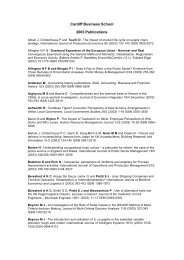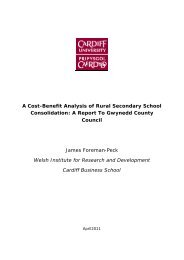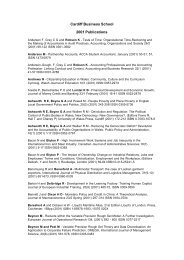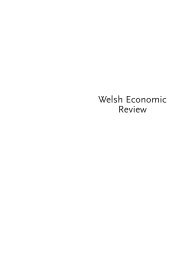Revisiting the Great Moderation using the Method of Indirect Inference
Revisiting the Great Moderation using the Method of Indirect Inference
Revisiting the Great Moderation using the Method of Indirect Inference
You also want an ePaper? Increase the reach of your titles
YUMPU automatically turns print PDFs into web optimized ePapers that Google loves.
Table 3: Performance <strong>of</strong> <strong>the</strong> Optimal Timeless Rule Model in <strong>the</strong> <strong>Great</strong> <strong>Moderation</strong><br />
Panel A: Directed Wald- data dynamics<br />
VAR(1) 95% 95% Values estimated In/Out<br />
coecients lower bound upper bound with real data<br />
11 0.7408 0.9689 0.8950 In<br />
12 -0.0316 0.0329 0.0395 Out<br />
13 -0.0709 0.0896 0.0315 In<br />
21 -0.2618 0.8132 -4.28e-05 In<br />
22 0.4102 0.7617 0.8243 Out<br />
23 -0.3954 0.3056 -0.0657 In<br />
31 -0.3197 0.2122 0.0105 In<br />
32 0.0050 0.1735 0.0979 In<br />
33 0.1090 0.5052 0.2353 In<br />
Directed Wald percentile<br />
for dynamics<br />
86.4<br />
Panel B: Directed Wald- data volatilities<br />
Volatilities <strong>of</strong> 95% 95% Values calculated In/Out<br />
endogenous variables lower bound upper bound with real data<br />
V ar(~{) 0.0042 0.0264 0.0156 In<br />
V ar(x) 0.0686 0.1627 0.1620 In<br />
V ar() 0.0095 0.0204 0.0149 In<br />
Directed Wald percentile<br />
for volatilities<br />
89.6<br />
Note: Estimates reported in panel B are magnied by 1000 times as <strong>the</strong>ir original values.<br />
Panel C: Full Wald statistic<br />
Chosen data features<br />
Full Wald percentile<br />
Dynamics+Volatilities 77.1<br />
95% upper bound, <strong>the</strong> test returns a directed Wald percentile <strong>of</strong> 86.4. This means at<br />
95% (or even at 90%) condence level <strong>the</strong> real-data-based estimates are easily explained<br />
by <strong>the</strong>ir joint distribution generated from model simulations, indicating that <strong>the</strong> model<br />
has in general captured <strong>the</strong> dynamic features <strong>of</strong> <strong>the</strong> data pretty precisely.<br />
Panel B <strong>the</strong>n examines <strong>the</strong> model's capacity to explain <strong>the</strong> data's volatility. It shows<br />
<strong>the</strong> observed data variances not only lie individually within <strong>the</strong> 95% bounds but are also<br />
jointly explained by <strong>the</strong> model at <strong>the</strong> 95% level (indeed, also marginally at 90%), since<br />
<strong>the</strong> directed Wald is 89.6. Thus compared to <strong>the</strong> data <strong>the</strong> Timeless Rule model is also<br />
23








